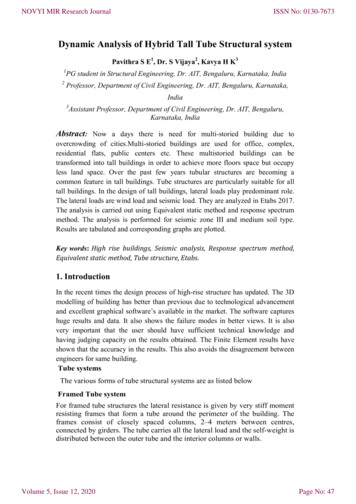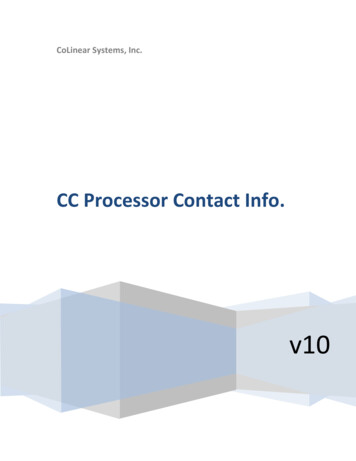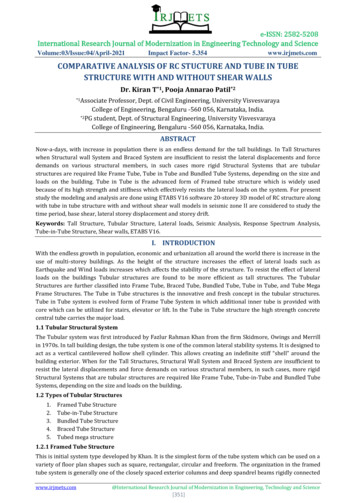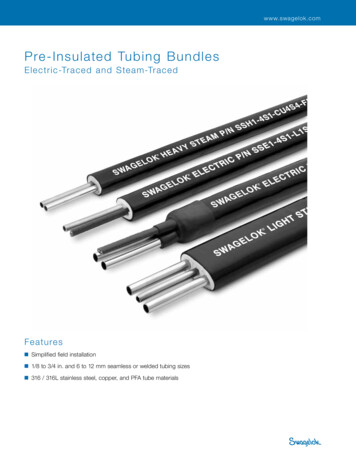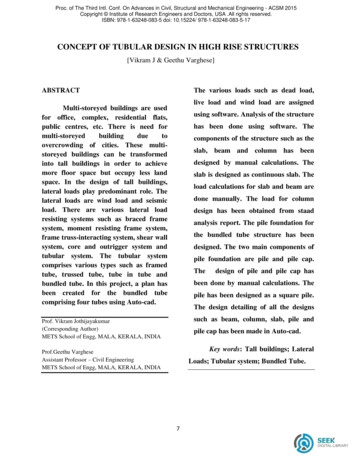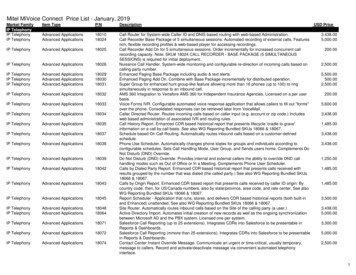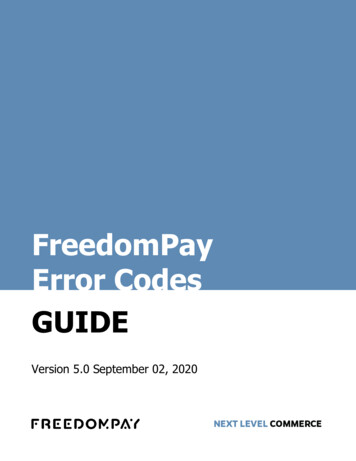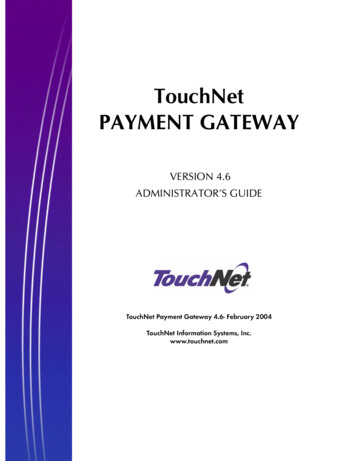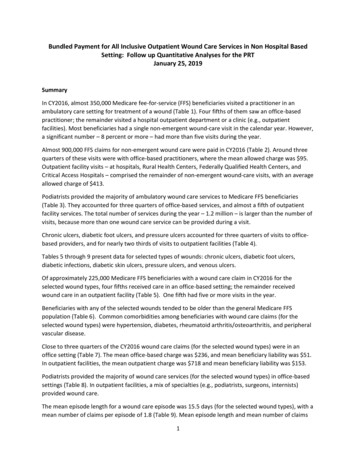
Transcription
Bundled Payment for All Inclusive Outpatient Wound Care Services in Non Hospital BasedSetting: Follow up Quantitative Analyses for the PRTJanuary 25, 2019SummaryIn CY2016, almost 350,000 Medicare fee-for-service (FFS) beneficiaries visited a practitioner in anambulatory care setting for treatment of a wound (Table 1). Four fifths of them saw an office-basedpractitioner; the remainder visited a hospital outpatient department or a clinic (e.g., outpatientfacilities). Most beneficiaries had a single non-emergent wound-care visit in the calendar year. However,a significant number – 8 percent or more – had more than five visits during the year.Almost 900,000 FFS claims for non-emergent wound care were paid in CY2016 (Table 2). Around threequarters of these visits were with office-based practitioners, where the mean allowed charge was 95.Outpatient facility visits – at hospitals, Rural Health Centers, Federally Qualified Health Centers, andCritical Access Hospitals – comprised the remainder of non-emergent wound-care visits, with an averageallowed charge of 413.Podiatrists provided the majority of ambulatory wound care services to Medicare FFS beneficiaries(Table 3). They accounted for three quarters of office-based services, and almost a fifth of outpatientfacility services. The total number of services during the year – 1.2 million – is larger than the number ofvisits, because more than one wound care service can be provided during a visit.Chronic ulcers, diabetic foot ulcers, and pressure ulcers accounted for three quarters of visits to officebased providers, and for nearly two thirds of visits to outpatient facilities (Table 4).Tables 5 through 9 present data for selected types of wounds: chronic ulcers, diabetic foot ulcers,diabetic infections, diabetic skin ulcers, pressure ulcers, and venous ulcers.Of approximately 225,000 Medicare FFS beneficiaries with a wound care claim in CY2016 for theselected wound types, four fifths received care in an office-based setting; the remainder receivedwound care in an outpatient facility (Table 5). One fifth had five or more visits in the year.Beneficiaries with any of the selected wounds tended to be older than the general Medicare FFSpopulation (Table 6). Common comorbidities among beneficiaries with wound care claims (for theselected wound types) were hypertension, diabetes, rheumatoid arthritis/osteoarthritis, and peripheralvascular disease.Close to three quarters of the CY2016 wound care claims (for the selected wound types) were in anoffice setting (Table 7). The mean office-based charge was 236, and mean beneficiary liability was 51.In outpatient facilities, the mean outpatient charge was 718 and mean beneficiary liability was 153.Podiatrists provided the majority of wound care services (for the selected wound types) in office-basedsettings (Table 8). In outpatient facilities, a mix of specialties (e.g., podiatrists, surgeons, internists)provided wound care.The mean episode length for a wound care episode was 15.5 days (for the selected wound types), with amean number of claims per episode of 1.8 (Table 9). Mean episode length and mean number of claims1
per episode ranged from 6.4 days and 1.3 claims (diabetic infection) to 18.4 days and 2.2 claims (venousulcers). The mean allowed charge for an episode was 591 and the mean beneficiary liability was 123(for the selected wound types).Data and definitionsThis analysis is based on tabulations of a 20-percent sample of Medicare FFS claims. A wound care visit isdefined as a claim that includes a wound diagnosis and a Current Procedural Terminology (CPT) orHealthcare Common Procedure Coding System (HCPCS) code indicating a wound care service. Wounddiagnoses are based on work by Nussbaum, Carter, Fife, et al.1 The original ICD-9 (InternationalClassification of Diseases, Ninth Revision) diagnosis codes were converted to ICD-10 using the CMSgeneral equivalence mappings, and codes were added to account for diabetic foot and skin ulcers thatexist in ICD-10 but not explicitly in ICD-9. Appendix A contains a list of these diagnosis codes. Appendix Bcontains a list of CPT and HCPCS codes used to identify wound care services.Visits were divided into outpatient facility and office-based settings using claims information. Facilityvisits were identified in Medicare outpatient claims; in order to distinguish visits for routine care fromthose for emergent care, the revenue center in which the wound care was billed was restricted to thosefor clinic-like services (see Appendix C for a list of these revenue centers). Office-based visits weredetermined from Medicare carrier claims; in order to be counted, the place of service must have beenone reimbursed under the Physician Fee Schedule as non-facility (see Appendix D for a list of the placesof service excluded).Allowed charges for outpatient facility and office-based visits were tabulated from the claims. In thecase of outpatient visits, the facility allowed charge from the outpatient claim was combined withpractitioner allowed charges by matching the service dates on the claims. In the case of FederallyQualified Health Centers, Rural Health Centers, and some Critical Access Hospitals, professional servicesare billed through the outpatient facility and there is no corresponding carrier claim.1An Economic Evaluation of the Impact, Cost, and Medicare Policy Implications of Chronic Nonhealing Wounds.Value in Health 21(2018) 27–32.2
Table of ContentsTable 1. Number of beneficiaries with specified number of Medicare Fee-for-Service non-emergentwound care claims, CY2016 . 4Table 2. Distribution of allowed charges for wound care in Medicare Fee-for-Service claims involvingnon-emergent wound care, CY2016 . 5Table 3. Number of Medicare Fee-for-Service non-emergent wound care services, by providerspecialty and place of service, CY2016 . 6Table 4. Wound care claims, by place of service and broad type of wound, CY2016 . 7Table 5. Number of beneficiaries with wound care for selected types of wounds,* by number ofclaims, CY2016 . 9Table 6. Characteristics of Medicare Fee-for-Service population and of the population with claims forwound care for selected types of wounds,* CY2016 . 10Table 7. Distribution of allowed charges and beneficiary liability for wound care, by type of wound,CY2016 . 11Table 8. Number of Medicare Fee-for-Service wound care services for selected types of wounds,* byprovider specialty and place of service, CY2016. 12Table 9. Episode length, allowed charges, and beneficiary liability for selected types of wounds,CY2016 . 13Appendix A. Diagnoses used to identify non-emergent wound claims . 14Appendix B. CPT and HCPCS codes used to identify wound care . 20Appendix C. Revenue centers included in determination of wound care for facility visits . 25Appendix D. Places of service excluded from office-based visits . 263
Table 1. Number of beneficiaries with specified number of Medicare Fee-for-Service non-emergent wound care claims, CY2016Number ofAll Types of ClaimsOutpatient Facility Claims *Office-Based** ClaimsBoth Outpatient Facility andclaims in CYOffice-Based Claims ***Number ofPercentNumber ofPercent ofNumber ofPercentNumber ofPercent ofbeneficiariesof totalbeneficiariestotalbeneficiariesof .01,7652.64,9501.74758.516 or more5,2001.51,4152.13,6801.33255.8SOURCE: Medicare Fee-for-Service 20-percent sample. See Appendices A and B for a list of diagnosis codes used to identify wound claims and CPT/HCPCScodes used to identify wound care.* Outpatient Facility claims are counted as wound care only if the care is provided in a revenue center suggestive of a clinic-type visit; for example, if theservice is provided in an emergency department, the claim is not counted.** All places of care except those paid under the Physician Fee Schedule as facility-based: Off Campus-Outpatient Hospital, Inpatient Hospital, On CampusOutpatient Hospital, Emergency Room – Hospital, Ambulatory Surgical Center, Inpatient Psychiatric Facility, Comprehensive Inpatient Rehabilitation Facility,Skilled Nursing Facility, Community Mental Health Center, Military Treatment Facility , Ambulance (Land, Air or Water), Hospice, Psychiatric Facility-PartialHospitalization, Psychiatric Residential Treatment Center*** These beneficiaries are included in counts for outpatient claims and office claims as well, according to the number of such claims they had.4
Table 2. Distribution of allowed charges for wound care in Medicare Fee-for-Service claims involving non-emergent wound care, CY2016Place of sted Living FacilityGroup HomeUrgent Care FacilityNursing FacilityCustodial Care FacilityIndependent ClinicNumber 0635Mean ChargesFacilityProvider99thOffice-based * 95---- 407 95---- 410 92---- 466 85---- 225 79---- 90 110---- 325 83---- 316 79---- 139 96---- 309Outpatient Facility*** 413 355 27 3,227 448 389 31 3,490 141 141 0 686 55 55 0 109Total95th 207 201 159 149 90 262 158 89 150Total Charges - Percentiles of Distribution90th75thMedian25th10th 141 142 114 92 88 197 89 88 131 86 86 86 83 85 107 79 85 107 77 76 77 76 74 91 71 77 80 71 71 74 71 73 82 69 72 80 68 68 71 68 72 73 67 70 655th1st 67 66 70 68 70 72 59 69 65 42 42 60 61 70 62 34 61 30Total **202,380 1,543 947 314 235 150 80 47 23Hospital-outpatient176,475 1,603 1,227 344 241 208 107 63 29Clinic-rural health4,995 272 240 185 135 71 27 0 0Clinic-Federally Qualified Health1,500 94 84 64 53 43 30 20 2Center (FQHC)85 Critical Access Hospital19,405 198 120 3 1,937 506 349 222 127 72 34 25 21SOURCE: Medicare Fee-for-Service 20-percent sample. See Appendices A and B for a list of diagnosis codes used to identify wound claims and CPT/HCPCS codes used to identifywound care.* All places of service except those paid under the Physician Fee Schedule as facility-based: Off Campus-Outpatient Hospital, Inpatient Hospital, On Campus-Outpatient Hospital,Emergency Room – Hospital, Ambulatory Surgical Center, Inpatient Psychiatric Facility, Comprehensive Inpatient Rehabilitation Facility, Skilled Nursing Facility, CommunityMental Health Center, Military Treatment Facility , Ambulance (Land, Air or Water), Hospice, Psychiatric Facility-Partial Hospitalization, Psychiatric Residential Treatment Center** Includes places of service not shown separately because of small claim counts*** Outpatient claims are counted as wound care only if the care is provided in a revenue center suggestive of a clinic-type visit; for example, if the service is provided in anemergency department the claim is not counted.5
480208119350977724440720650125Table 3. Number of Medicare Fee-for-Service non-emergent wound care services, by provider specialty and place of service, CY2016SpecialtyTotalOutpatient Facility *Office-Based**Number ofPercentNumber ofPercent of Number ofPercentservices ***of totalservices ***totalservicesof total***Total n – Podiatry608,93550.696,63018.7512,30574.6Physician - General Surgery114,0409.599,19519.214,8452.2Physician - Family Practice106,7108.968,57513.338,1355.6Physician - Internal Medicine64,0655.351,1759.912,8901.9Physician - Emergency Medicine61,4455.149,0009.512,4451.8 Nurse Practitioner56,5754.741,5008.015,0752.2 Physician Assistant27,7452.311,7102.316,0352.3Physician - Vascular Surgery21,6351.817,0653.34,5700.7Physician - Plastic and Reconstructive Surgery21,1051.816,7803.24,3250.6Physician - Infectious Disease17,9601.513,5602.64,4000.6Physician – Dermatology14,4201.27350.113,6852.0Physician - Orthopedic Surgery13,3251.110,7852.12,5400.4 Portable X-ray Supplier (billing independently)11,9951.000.011,9951.7Physician - General Practice11,8351.07,0901.44,7450.7Physician - Physical Medicine and Rehabilitation10,6000.97,2101.43,3900.5Other physician specialties38,0703.224,9154.813,1551.9Other non-physician specialties3,5750.31,2900.22,2850.3SOURCE: Medicare Fee-for-Service 20-percent carrier claim sample. See Appendices A and B for a list of diagnosis codes used to identify wound claims and CPT/HCPCS codesused to identify wound care.* Includes on-campus and off-campus settings.** All places of service except those paid under the Physician Fee Schedule as facility-based: Off Campus-Outpatient Hospital, Inpatient Hospital, On Campus-OutpatientHospital, Emergency Room – Hospital, Ambulatory Surgical Center, Inpatient Psychiatric Facility, Comprehensive Inpatient Rehabilitation Facility, Skilled Nursing Facility,Community Mental Health Center, Military Treatment Facility , Ambulance (Land, Air or Water), Hospice, Psychiatric Facility-Partial Hospitalization, Psychiatric ResidentialTreatment Center*** Services are distinct procedures performed during a visit. Claims can comprise more than one service (and typically do).**** Includes specialties not listed separately because of small sample sizes.6
1112132032334913717785Table 4. Wound care claims, by place of service and broad type of wound, CY2016Place of service *All ot UlcerInfectionAll isted Living Facility5,1551302,56080--Urgent Care Facility31,5500130----Nursing Facility6,2851352,805215--Custodial Care Facility1,83017095060--Independent Clinic635--285--0Other525--220120--Outpatient tpatient176,4752,89558,31531,495775Clinic-rural health4,995--1,215500--Clinic-Federally Qualified Health1,500--490230--Center (FQHC)Critical Access Hospital19,4052855,9153,315240DiabeticSkin -5852,615SOURCE: Medicare Fee-for-Service 20-percent carrier claim sample. See Appendix A for a list of diagnosis codes used to identify wound claims andCPT/HCPCS codes used to identify wound care.--- suppressed due to cell size* Totals include places of service not shown separately** All places of care except those paid under the Physician Fee Schedule as facility-based: Off Campus-Outpatient Hospital, Inpatient Hospital, On CampusOutpatient Hospital, Emergency Room – Hospital, Ambulatory Surgical Center, Inpatient Psychiatric Facility, Comprehensive Inpatient Rehabilitation Facility,Skilled Nursing Facility, Community Mental Health Center, Military Treatment Facility , Ambulance (Land, Air or Water), Hospice, Psychiatric Facility-PartialHospitalization, Psychiatric Residential Treatment Center*** Columns do not add to the total because beneficiaries with more than one type of wound care are counted more than once.**** Outpatient claims are counted as wound care only if the care is provided in a revenue center suggestive of a clinic-type visit; for example, if the serviceis provided in an emergency department the claim is not counted.7
1112132032334913717785Table 4 (continued). Wound care claims, by place of service and broad type of wound, CY2016Place of service *All ections InfectionsWounds WoundsAll Visits889,19019,1003,005 84,71013,2602,010 5,6307,65575,980Visits686,81516,4802,905 8,70510,90084,195Office615,91016,0652,800 7,66510,52052,075Home24,925285--- 330601,170Assisted Living Facility5,15560--- ----250Urgent Care Facility31,550----- 52026030,390Nursing Facility6,285----- 105--175Custodial Care Facility1,830----- ------Independent Clinic635--0 ------Other525----- ----65Outpatient Facility****Beneficiaries***67,4151,46580 1,4405,77515,030Visits202,3802,620100 2,53013,54019,625Hospital-outpatient176,4752,26095 2,03512,26513,910Clinic-rural health4,99580--- --1902,540Clinic-Federally Qualified1,500----- 9060435Health Center (FQHC)Critical Access Hospital19,405235--- 65---552,035SOURCE: Medicare Fee-for-Service 20-percent carrier claim sample. See Appendix A for a list of diagnosis codes used to identify wound claims andCPT/HCPCS codes used to identify wound care.--- suppressed due to cell size* Totals include places of service not shown separately** All places of care except those paid under the Physician Fee Schedule as facility-based: Off Campus-Outpatient Hospital, Inpatient Hospital, On CampusOutpatient Hospital, Emergency Room – Hospital, Ambulatory Surgical Center, Inpatient Psychiatric Facility, Comprehensive Inpatient Rehabilitation Facility,Skilled Nursing Facility, Community Mental Health Center, Military Treatment Facility , Ambulance (Land, Air or Water), Hospice, Psychiatric Facility-PartialHospitalization, Psychiatric Residential Treatment Center*** Columns do not add to the total because beneficiaries with more than one type of wound care are counted more than once.**** Outpatient claims are counted as wound care only if the care is provided in a revenue center suggestive of a clinic-type visit; for example, if the serviceis provided in an emergency department the claim is not counted.8
Table 5. Number of beneficiaries with wound care for selected types of wounds,* by number of claims, CY2016Number ofAll types of claimsOutpatient Facility Claims**Office-based claims***Both Outpatient Facility andclaims inOffice-based Claims****CY2016Number ofPercent ofNumber ofPercent ofNumber ofPercent ofNumber ofPercent 2.71,4503.14,5352.541510.816 or more4,6852.11,2202.63,3851.92656.9SOURCE: Medicare Fee-for-Service 20-percent sample. See Appendix A for a list of diagnosis codes used to identify wound claims andCPT/HCPCS codes used to identify wound care.* Limited to the following broad wound types: chronic ulcers, diabetic foot ulcers, diabetic infections, diabetic skin ulcers, pressure ulcers, andvenous ulcers** Outpatient claims are counted as wound care only if the care is provided in a revenue center suggestive of a clinic-type visit; for example, ifthe service is provided in an emergency department the claim is not counted.*** All places of care except those paid under the Physician Fee Schedule as facility-based: Off Campus-Outpatient Hospital, InpatientHospital, On Campus-Outpatient Hospital, Emergency Room – Hospital, Ambulatory Surgical Center, Inpatient Psychiatric Facility,Comprehensive Inpatient Rehabilitation Facility, Skilled Nursing Facility, Community Mental Health Center, Military Treatment Facility ,Ambulance (Land, Air or Water), Hospice, Psychiatric Facility-Partial Hospitalization, Psychiatric Residential Treatment Center**** These beneficiaries are included in counts for outpatient claims and office claims as well, according to the number of such claims theyhad.9
Table 6. Characteristics of Medicare Fee-for-Service population and of the population with claims for wound care for selected types ofwounds,* CY2016CharacteristicTotal Part B FFS PopulationPopulation with 1 claim in any Population with 5 claims in any ofof the selected wound typesthe selected wound typesFFS beneficiaries36,512,836224,90037,675AgeUnder age 6516.9%17.2%20.8%Ages 65-6925.914.516.3Ages 70-7419.615.917.5Ages 75 and 46.0Selected chronic conditionsDiabetes End-of-Year Flag27.061.568.3Heart Failure End-of-Year Flag13.536.438.0Rheumatoid Arthritis /31.352.851.7OsteoarthritisHypertension End-of-Year Flag55.583.385.0Mobility Impairments2.87.57.9Obesity14.630.434.9Peripheral Vascular Disease11.854.159.7SOURCE: Medicare Fee-for-Service 20-percent sample. See Appendix A for a list of diagnosis codes used to identify wound claims andCPT/HCPCS codes used to identify wound care.* Limited to the following broad wound types: chronic ulcers, diabetic foot ulcers, diabetic infections, diabetic skin ulcers, pressure ulcers, andvenous ulcers10
MeasureTable 7. Distribution of allowed charges and beneficiary liability for wound care, by type of wound, CY2016Wound TypeChronicDiabetic Foot kin yMean25th percentileMedian75th percentileMean25th percentileMedian75th 549,160 236 75 111 167 51 15 23 36160,280Mean25th percentileMedian75th percentileMean25th percentileMedian75th percentile 718 233 326 668 153 48 72 152Office-based*340,60070,350 223 313 74 73 110 98 163 169 48 66 15 15 23 22 35 37Outpatient Facility**65,93535,540 637 231 303 571 134 48 68 128 874 238 363 840 185 49 77 189VenousUlcers5,815 256 99 157 277 54 19 32 554,955 334 83 141 197 69 17 28 39104,100 156 76 110 162 35 15 23 3523,340 528 90 162 259 107 18 33 581,0306,92029,43021,425 1,917 246 499 1,603 449 65 123 364 815 240 357 754 175 49 79 168 634 226 316 629 136 47 69 140 733 243 339 766 159 51 74 175SOURCE: Medicare Fee-for-Service 20-percent sample. See Appendix A for a list of diagnosis codes used to identify wound claims and CPT/HCPCS codes used to identifywound care.* All places of care except those paid under the Physician Fee Schedule as facility-based: Off Campus-Outpatient Hospital, Inpatient Hospital, On Campus-Outpatient Hospital,Emergency Room – Hospital, Ambulatory Surgical Center, Inpatient Psychiatric Facility, Comprehensive Inpatient Rehabilitation Facility, Skilled Nursing Facility, CommunityMental Health Center, Military Treatment Facility , Ambulance (Land, Air or Water), Hospice, Psychiatric Facility-Partial Hospitalization, Psychiatric Residential TreatmentCenter11
Table 8. Number of Medicare Fee-for-Service wound care services for selected types of wounds,* by provider specialty and place of service, CY2016Place of Ulcer137,66548Physician - Podiatry573,40091,210482,190372,15502Physician - General Surgery91,94582,0959,85042,07508Physician - Family Practice64,49055,9058,58511Physician - Internal Medicine48,65544,5304,12593Physician - Emergency Medicine43,26541,2302,03577Physician - Vascular Surgery16,89013,42044Physician - Infectious Disease14,44524Physician - Plastic and Reconstructive Surgery25Provider SpecialtyTotalOutpatientFacility**Wound abeticSkin 0551,575Physician - Physical Medicine and ,64001Physician - General ysician - Orthopedic ician - Preventive Medicine5,3705,1002702,6251,145**81562505Physician - hysician - Dermatology2,8153852,4302,1600**200435Other physician 52,78550Nurse 4705,73597Physician ortable X-ray Supplier (billing er non-physician specialties1,5601,085475850150**280200SOURCE: Medicare Fee-for-Service 20-percent sample. See Appendix A for a list of diagnosis codes used to identify wound claims and CPT/HCPCS codes used to identify woundcare.* Limited to the following broad wound types: chronic ulcers, diabetic foot ulcers, diabetic infections, diabetic skin ulcers, pressure ulcers, and venous ulcers** Outpatient claims are counted as wound care only if the care is provided in a revenue center suggestive of a clinic-type visit; for example, if the service is provided in anemergency department the claim is not counted.*** All places of care except those paid under the Physician Fee Schedule as facility-based: Off Campus-Outpatient Hospital, Inpatient Hospital, On Campus-Outpatient Hospital,Emergency Room – Hospital, Ambulatory Surgical Center, Inpatient Psychiatric Facility, Comprehensive Inpatient Rehabilitation Facility, Skilled Nursing Facility, CommunityMental Health Center, Military Treatment Facility , Ambulance (Land, Air or Water), Hospice, Psychiatric Facility-Partial Hospitalization, Psychiatric Residential Treatment Center12
MeasureTable 9. Episode length, allowed charges, and beneficiary liability for selected types of wounds, CY2016Wound nousUlcersFoot UlcerInfectionSkin UlcerUlcersUlcersEpisodes*Mean25th percentileMedian75th percentileMeanNumber of 25th percentileclaimsMedian75th percentileMean25th percentileAllowedchargesMedian75th percentileMeanBeneficiary 25th percentileLiabilityMedian75th percentileEpisodelength(days)169,95015.511151.8112 591 115 184 374 123 23 38 80101,25515.011151.7112 481 110 170 316 99 22 35 6821,62017.011221.9112 955 127 227 532 198 26 47 11530356.41111.3111 745 141 225 330 153 28 45 67286015.511211.8112 1,359 191 387 1,001 276 39 79 20832,65516.011151.7112 423 115 178 345 90 23 37 75852518.411272.2112 1,301 198 437 1,058 274 42 91 232All woundtypes with5 visits992089.654841187.4568 3,249 598 1,055 2,521 673 120 221 525SOURCE: Medicare Fee-for-Service 20-percent sample. See Appendix A for a list of diagnosis codes used to identify wound claims and CPT/HCPCS codes usedto identify wound care.* Episodes are limited to those that began on or after March 1, 2016 and concluded before or on October 31, 2016. An episode is considered completewhen more than a selected number of days passes without a wound care claim (chosen based on analysis of claims data):Pressure ulcers, venous ulcers: 70 daysOther wounds: 64 days13
Appendix A. Diagnoses used to identify non-emergent wound claimsWound TypeICD-10 CodesARTERIALULCERSI70.231, I70.232, I70.233, I70.234, I70.235, I70.238, I70.239, I70.241, I70.242,I70.243, I70.244, I70.245, I70.248, I70.249, I70.25, I70.261, I70.262, I70.263,I70.268, I70.269, CHRONIC ULCERSI70.331, I70.332, I70.333, I70.334, I70.335,I70.338, I70.339, I70.341, I70.342, I70.343, I70.344, I70.345, I70.348, I70.349,I70.35, I70.431, I70.432, I70.433, I70.434, I70.435, I70.438, I70.439, I70.441,I70.442, I70.443, I70.444, I70.445, I70.448, I70.449, I70.45, I70.531, I70.532,I70.533, I70.534, I70.535, I70.538, I70.539, I70.541, I70.542, I70.543, I70.544,I70.545, I70.548, I70.549, I70.55, I70.631, I70.632, I70.633, I70.634, I70.635,I70.638, I70.639, I70.641, I70.642, I70.643, I70.644, I70.645, I70.648, I70.649,I70.65, I70.731, I70.732, I70.733, I70.734, I70.735, I70.738, I70.739, I70.741,I70.742, I70.743, I70.744, I70.745, I70.748, I70.749, I70.75, L97.101, L97.102,L97.103, L97.104, L97.109, L97.111, L97.112, L97.113, L97.114, L97.119, L97.121,L97.122, L97.123, L97.124, L97.129, L97.201, L97.202, L97.203, L97.204, L97.209,L97.211, L97.212, L97.213, L97.214, L97.219, L97.221, L97.222, L97.223, L97.224,L97.229, L97.301, L97.302, L97.303, L97.304, L97.309, L97.311, L97.312, L97.313,L97.314, L97.319, L97.321, L97.322, L97.323, L97.324, L97.329, L97.401, L97.402,L97.403, L97.404, L97.409, L97.411, L97.412, L97.413, L97.414, L97.419, L97.421,L97.422, L97.423, L97.424, L97.429, L97.501, L97.502, L97.503, L97.504, L97.509,L97.511, L97.512, L97.513, L97.514, L97.519, L97.521, L97.522, L97.523, L97.524,L97.529, L97.801, L97.802, L97.803, L97.804, L97.809, L97.811, L97.812, L97.813,L97.814, L97.819, L97.821, L97.822, L97.823, L97.824, L97.829, L97.901, L97.902,L97.903, L97.904, L97.909, L97.911, L97.912, L97.913, L97.914, L97.919, L97.921,L97.922, L97.923, L97.924, L97.929, L98.411, L98.412, L98.413, L98.414, L98.419,L98.421, L98.422, L98.423, L98.424, L98.429, L98.491, L98.492, L98.493, L98.494,L98.499, M72.6DIABETIC FOOTULCERE08.621, E09.621, E10.621, E11.621DIABETICINFECTIONA31.1, A43.1, A48.0, B95.1, L02.611, L02.612, L02.
* All places of service except those paid under the Physician Fee Schedule as facility-based: Off Campus-Outpatient Hospital, Inpatient Hospital, On Campus-Outpatient Hospital, Emergency Room – Hospital, Ambulatory Surgical Center, Inpatient Psychiatric Facility, Comprehensive Inpatient Reh
